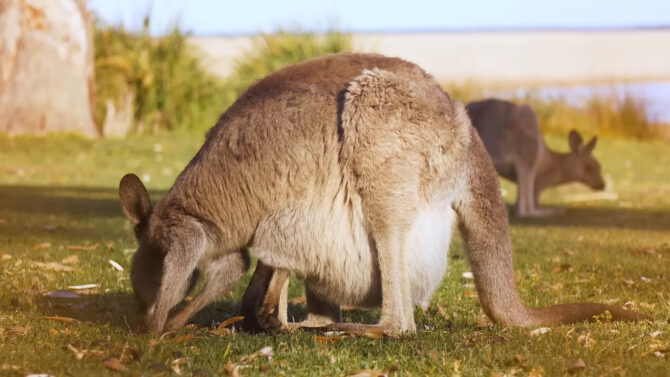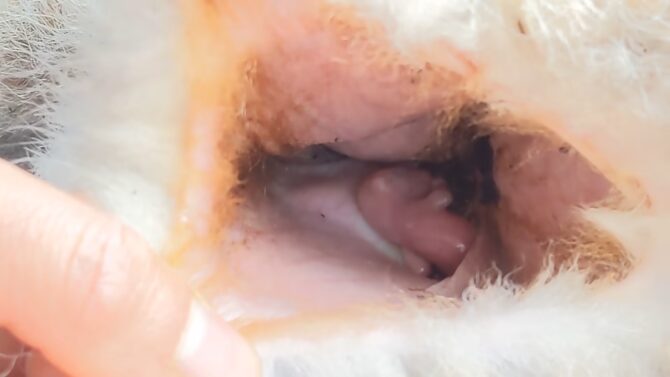The image of a kangaroo often invokes the sight of a marsupial mother hopping around the Australian outback with a cute little “joey” peeking out from her pouch. But have you ever wondered what exactly is inside? How does it work, and why is it there? This blog post will talk about the mysteries of the kangaroo pouch, revealing what lies within and why it’s so essential to the survival of these iconic Australian mammals.
The Basics
Kangaroos are marsupials, a group of mammals unique in their reproductive system. Central to this is the pouch, or marsupium. Before we delve deeper, let’s begin with the basics.
Definition and Purpose
The kangaroo pouch is more than just a pocket; it’s a specially designed organ made of strong muscles and lined with sweat glands. Its primary purpose is to nurture and protect the undeveloped offspring called “joeys.” Once the joey is born, it’s tiny, almost worm-like, blind, and hairless. The pouch serves as a protective space where the young can continue to develop, feeding on its mother’s milk and growing until it’s ready to face the outside world.
Anatomy
Contrary to popular belief, the pouch isn’t just a simple flap of skin. The opening has strong muscles that allow the mother to tighten or loosen its grip, keeping the young ones safe inside or allowing them to peek out when they’re older. Inside, the pouch is warm and humid, creating a perfect environment for the undeveloped joey. It’s lined with soft fur and contains teats that produce milk. Interestingly, these teats can produce different types of milk simultaneously, catering to joeys of different developmental stages.
Lifecycle
The pouch is central to the kangaroo’s reproductive cycle. From conception to joey’s venture into the outside world, it plays various roles.
Birth to Pouch

When a joey is born, it’s only about the size of a lima bean. Despite its small size and underdeveloped state, it has strong forelimbs, which it uses to climb from the birth canal into the pouch. This journey takes about three minutes. Once inside the pouch, the joey attaches itself to one of the teats, which then swells in its mouth, securing it in place. Here, in the safety and warmth, the joey will continue to grow and develop for several months.
Transitioning Out
After several months inside the pouch, joey begins to peek out, taking in the world outside. As it grows larger and more developed, it will spend increasing amounts of time outside, returning only to feed. Around eight months or so, the joey will leave the pouch for the last time. However, it will continue to nurse, feeding from the teats outside until it becomes fully independent.
Fascinating Facts
The kangaroo pouch is a marvel of nature. Here are some fascinating tidbits that showcase its wonder.
- Hygiene: Mother kangaroos often clean their pouches, licking the inside to keep it free from dirt and parasites. This ensures a safe environment for the developing joey.
- Thermal Regulation: The temperature inside is regulated to keep the joey warm. It can be up to 10°C warmer inside than the external environment.
- Different Milk for Different Stages: As mentioned, kangaroo teats can produce various milk types. The composition of the milk changes as the joey grows, ensuring it gets the right nutrients at each stage of its development.
The Science
While the kangaroo pouch might seem straightforward, there’s a wealth of complexity and fascinating science underpinning its function. Let’s take a more detailed look.
Pouch Microbiome: A World Inside
Just like our guts, the kangaroo pouch has its unique set of microbes, which play a crucial role in maintaining its health and functionality. Recent studies have revealed that the microbiome inside changes over time, especially during the early stages of a joey’s life. These microbes help in preventing infections and aid in the digestion of the milk by the joey. The dynamic nature of the pouch’s microbiome ensures that the baby kangaroo gets the best start to life, free from harmful pathogens and supported by beneficial bacteria.
Evolutionary Marvel

The kangaroo pouch, as we see it today, is the result of millions of years of evolutionary refinement. Early marsupials likely didn’t have pouches. Instead, they might have had flaps of skin or even just a region on their belly where the young clung to. Over time, as marsupials faced various environmental challenges, the pouch evolved as a secure means of protecting their young. It provided a sheltered environment, ensuring a higher survival rate for the offspring, thus passing on the genetic trait of having it.
Kangaroo Pouches and Human Inspiration
The wonders of nature often inspire human innovation. The kangaroo pouch, with its multifaceted utility, has not been an exception.
Biomedical Insights
The unique microbiome and the controlled environment of the kangaroo pouch have piqued the interest of biomedical researchers. By studying its ecosystem, scientists hope to gain insights into treating infections, enhancing neonatal care, and even understanding human gut health better.
Fashion and Design
When we first opened our doors, we were making bib overalls for farm and ranch workers in Fort Worth, Texas. 100 years later, we’re still doing it. #DickiesWorkwear pic.twitter.com/Ek6zIs0aAt
— Dickies® (@Dickies) August 9, 2022
Beyond science, the kangaroo pouch has even made its mark in the world of fashion. The “kangaroo pocket” seen on hoodies and sweatshirts is inspired by the marsupial’s pouch. Its utility and design have made it a staple in casual wear worldwide.
FAQs
How can one describe the inside of a kangaroo’s pouch?
The inside feels like the texture of the kangaroo’s skin but is hairless. It is soft and can be compared to the skin on the inside of a human’s wrist. The pouch maintains a warm temperature, similar to the mother’s body temperature, which is around 105 degrees Fahrenheit (40.5 degrees Celsius).
What does the kangaroo’s pouch contain?
It contains four teats or milk ducts. These teats provide nourishment to the joey.
How does a newborn joey reach the pouch?
After birth, which occurs after about 32 or 33 days of gestation, the newborn joey, which is tiny and weighs less than a gram, uses its forelimbs to crawl up inside. Once inside, it latches onto a teat for nourishment.
How long does a joey stay inside the pouch?
A joey remains inside for approximately four-and-a-half to five months. After this period, it starts to venture out but stays close to its mother, returning to the pouch frequently. By 8 months, the joey becomes more adventurous, and by 10 to 12 months, it stops returning.
Do joeys defecate inside the pouch?
Yes, they do, especially during the early months when they remain inside continuously. As they grow and start exploring outside, they also bring dirt inside.
How do mother kangaroos keep their pouches clean?
Mother kangaroos engage in cleaning by sticking their heads inside and using their tongues to scrape out dirt and droppings. This might involve working around a young joey or temporarily evicting an older one.
How many joeys can a kangaroo give birth to at a time?
Kangaroos typically give birth to one joey at a time. However, after mating, if conditions aren’t favorable for raising a baby, the kangaroo’s body can delay the implantation of the embryo. This means a female kangaroo can give birth to multiple young over a span of a year or more from a single mating instance.
Can a mother kangaroo produce milk for joeys of different ages simultaneously?
Yes, a mother kangaroo’s body can produce different types of milk nutrients suitable for joeys of varying ages. For instance, one teat can produce milk for an 8-month-old joey, while another teat can produce milk suitable for a newborn.
Are kangaroos the only marsupials with pouches?
No, many marsupials have them, including opossums, Tasmanian devils, and koalas. However, kangaroos are perhaps the most iconic among them.
Closing Thoughts
The kangaroo pouch is another proof of the marvels of evolution and nature’s ingenious solutions to reproductive challenges. Marsupials, like kangaroos, have evolved a unique method of reproduction, where the pouch plays a pivotal role. It’s not just a bag but a dynamic organ that offers warmth, protection, and sustenance.
Similarly, in other parts of the world, animals like pangolins have developed unique features, such as protective scales, to adapt to their environment and challenges.






